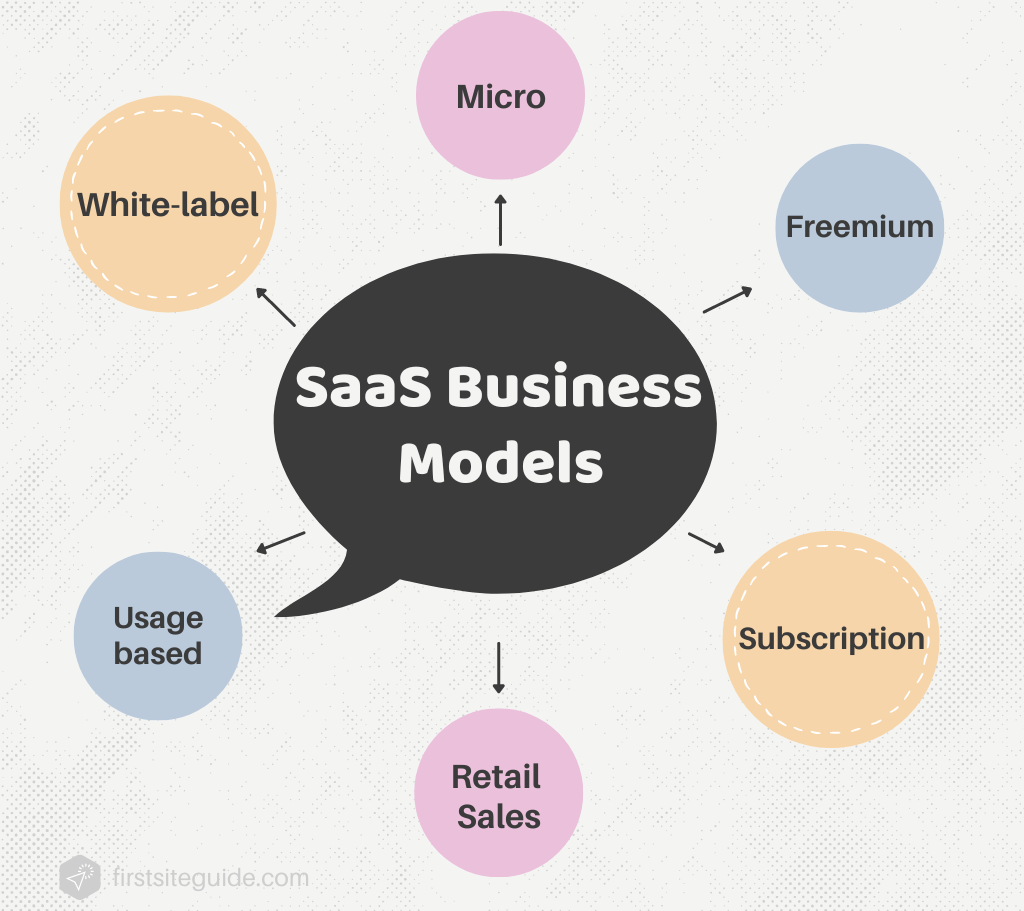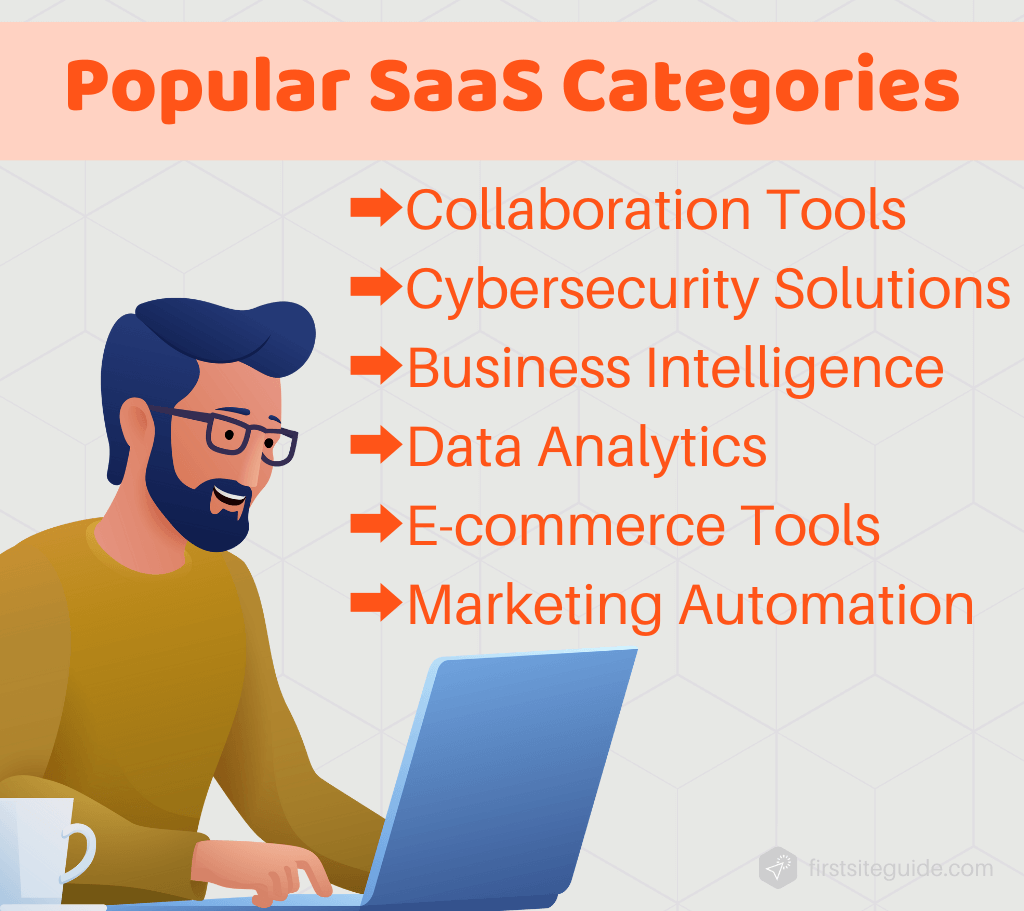Top SaaS Business Ideas to Explore in 2024

If you’re on a mission to conquer the tech industry, you’ll need fresh and innovative SaaS business ideas to beat your competitors and disrupt the already saturated market. As a SaaS entrepreneur, executive, or startup founder, you need innovation to launch a unique venture that will become the next big thing in tech.
Though the SaaS market brings many lucrative opportunities, numerous business challenges require capital, grit, and immense commitment to overcome. Thankfully, the SaaS business model gives you access to the cloud-based software market, allowing you to establish viable ventures and scale your operations efficiently.
According to the latest forecasts, the SaaS business market is booming and expected to grow in the coming time. Since the software business industry is overwhelmingly competitive and increasingly more regulated, picking the right market and target audience is critical to your success.
With that in mind, here are the best SaaS business ideas you should keep on your radar to help you navigate the murky waters of the software business industry and evaluate the viability of your SaaS entrepreneurship.
What is a SaaS business?
SaaS stands for Software as a Service. This business model is the most popular way to launch digital services in 2024. Since the cloud-based software market is rapidly expanding, starting a SaaS business today allows you to tap into a thriving industry and harness the full potential of innovative software products, such as digital apps, software tools, project management systems, etc.
Now, a SaaS business organization hosts a software system or an application to make it readily available to the target audience over the internet. The clients pay a subscription to access the online service remotely. There are two established ways to start a SaaS business. Firstly, you can start a SaaS company and launch a certain type of software-based product for your customers.
The second option is to white-label an already established SaaS company. This is by far the quickest, easiest, and cheapest way to get into the SaaS business. In this article we’re primarily focusing on starting your own SaaS company. We’ll briefly touch on white-label SaaS options a little later on and more in depth in future content.
When you start a SaaS company, you are in charge of maintaining the software and its databases and servers to enable your clients to access the service over the web using their web browsers, mobile devices, or any other device they prefer. In return, your clients pay a subscription fee on a monthly or annual basis to ensure steady access to the service.
You can use different pricing methods to charge your clients for the subscription. For example, you can charge by the level of tech support your customers require or the number of users who will have access to the service. Additional options include basing your subscription plans on the amount of data a client requires or just a flat fee for software access.
If you have any concerns about the profitability of the SaaS industry, here are some stats to help you get a better understanding of this thriving market:
- By 2024, the SaaS industry will have grown from $197 to $232 billion;
- At the moment, the SaaS market counts over 59 billion SaaS clients worldwide;
- The market shows the potential for steady growth over the next six years.
As you can see, you’re dealing with a highly profitable business niche here. Hence, the emphasized importance of tapping into the best, most profitable, and most market-distrupting SaaS business ideas in 2024.
Basic requirements of starting a SaaS business
Before we outline the basic requirements of starting a SaaS company, let’s quickly explain why you should consider venturing into such a business endeavor:
- Worldwide market – the SaaS business market gives you global access to target audiences. With such a high demand, you won’t have to worry about reaching the right customers. In addition, the cloud-based software service makes your business accessible to anyone, anywhere, at any time.
- Streamlined software maintenance – software startups have the advantage of leaving the software maintenance to the software provider. Since establishing the right maintenance system for your services is one of the biggest challenges in the industry, this streamlined software maintenance can help you focus on the core mission while avoiding additional expenses.
- Scalable operation – thanks to the available automation solutions, you can streamline the process of upscaling your SaaS software products to ensure your business can cope with the ever-increasing amounts of data and customer demand. This scaling ability also gives you a competitive advantage over other companies in your niche.
- Pre-calculated development and low entry costs – with the pre-calculated costs of developing SaaS products and no hardware costs involved, it will be much easier to develop and launch your SaaS products to enter the industry without breaking the bank.
Let’s briefly review the essentials you’ll need to start a SaaS business in 2024.
Your startup name
The first step to starting a SaaS business is to choose a simple and memorable name. You need a name that will stand out and convey the company profile memorably and attractively. Check your competitors to come up with something similar but better.
Product requirements
Once you have a catchy name figured out, think about the SaaS product you want to develop. Think about its strengths, advantages, benefits, etc. Your product should offer a solution to common pain points of your target audience.
Break down the basic product requirements, such as:
- Design features;
- Advantages of the product;
- How the product benefits users in real life;
- How it solves real-life problems;
- Customer testimonials and examples of use by clients.
Understanding all these points will help you a lot when developing your product as well as knowing exactly how to position it in the market.
Hire the right SaaS developer
Now, it’s time to get on with the software development lifecycle. We recommend outsourcing your software needs to a development team as per your software’s requirements.
Creating a modern, innovative, and user-friendly UI/UX design is paramount to launching a market-disturbing SaaS product and attracting the right target audience.
Find a software development team that can go about your development and design needs.
This process has gotten increasingly easier with the advent of online freelance services like Fiverr, Upwork, and Toptal.
Build the product
With the right team on your side, building your SaaS product should be straightforward. At this point, time is of the essence.
So, talk to your developers about how much it will take to develop your product or service and understand the implementation requirements. They should inform you of the project status throughout the development cycle.
Follow the legal rules and regulations
Every industry is subject to strict state and federal legal regulations. Understanding these formalities can help you avoid unnecessary risks and complications associated with implementing a SaaS business. Register your business by following the niche-specific regulations.
Explore the law regarding starting a SaaS business in your state or country. In addition, do your due diligence regarding data privacy, business insurance, industry compliance standards, and all the permits and licenses your type of business entails.
If you haven’t already, it’s wise to also start a Limited Liability Company (LLC) for your SaaS business to protect yourself and your personal assets. You can do this yourself or hire a service to start an LLC on your behalf for a small fee.
Don’t forget about advertising
While you should focus your investment capital on development, design, and other essential SaaS startup processes, don’t forget to allocate some of your budget to a proper advertising campaign.
Promotion helps your target audience learn about your brand, product, and business in general. Thankfully, you have multiple communication channels for promoting your business these days. A website, email marketing service, and social media networks are just the tip of the iceberg.
Building a website doesn’t have to be intimidating, check out our website step-by-step guide.
Track your progress
Once you have everything up and ready, track your progress to quickly identify obstacles, mitigate cart abandonment, monitor monthly income, and ascertain average revenue per client.
Common challenges of starting a SaaS business and opportunities
Let’s delve deeper into common SaaS business startup challenges and how to overcome them.
How to overcome common SaaS challenges
Below are the common challenges and the best ways to beat them.
Data privacy and security concerns
Though cloud-based apps offer high-end security measures, they aren’t immune to increasing data privacy and security concerns. Your clients must be able to rely on you to comply with the latest data privacy compliance regulations and safeguard sensitive data.
Prioritize security measures such as the latest encryption, blockchain-enabled cybersecurity, AI-powered security systems, two-step authentication, etc.
Service reliability
All SaaS services depend on internet connectivity. This is more of a concern if you’re running a SaaS business in a country with unreliable internet services, you could face service disruptions and downtime.
You can solve this by outsourcing your internet connectivity needs to countries with reliable providers to avoid hindering your operations.
Limited customization
Avoid the common mistake of offering limited customization options, as you could lose clients with specific needs. Adding new options could expose you to new challenges like vendor lock-in, data migration issues, and additional costs.
Make sure you introduce a healthy number of customization options in the development phase as per your clients’ needs but know as well that you can always roll out more options once your SaaS is launched and producing revenue.
Pricing model restrictions
Though the subscription-based pricing model may be cost-effective, it can incur long-term expenses. Therefore, you need a flexible pricing structure to accommodate the ever-changing client needs. Such pricing models should also be scalable enough to fit the needs of different clients.
Finding scalability and growth opportunities
Though no one can guarantee that your SaaS business idea will work, you should build a business around the possibility of future expansion. The ability to scale your operations on demand gives you a huge competitive advantage and ensures your company identifies lucrative and feasible growth opportunities.
One of the best ways to make your SaaS company scalable is to consider migrating your software architecture to a multi-tenant database environment. In simple words, you can share a single software instance with multiple SaaS businesses to seamlessly scale your SaaS services by dynamically allocating the resources according to your needs.
Navigating competition and staying on top
Aside from identifying challenges, faulty systems, and scaling problems, you should also work on staying ahead of the competition by learning to navigate the market and industry trends. Remember, the SaaS market is still evolving.
Staying ahead of the ongoing and coming trends is paramount to beating your competitors to the best, most profitable business concepts. However, you’ll need to find your expertise first to get ahead of the curve and stay on top of the current and future market trends.
Learn from your competitors and take their ideas as creative suggestions. Keep researching the market, leading companies, and everything else related to the industry to get the best SaaS startup ideas you can work with.
Different SaaS business idea models for 2024
Now that you have a basic understanding of the SaaS business market, let’s tap into the top SaaS business idea models for 2024.

White-label SaaS
As we mentioned earlier, the white-label SaaS business model allows you to invest in an existing SaaS product, rebrand it as your own, and market it to your target audience for a subscription fee.
Your clients pay a fee to get online access to your product on a recurring basis. Top white-label SaaS products include email marketing, SEO, chatbots, social media automation, etc.
One white-label SaaS company that has been growing quickly in popularity over the last several years is GoHighLevel, which is an all-in-one marketing platform, but there are plenty of other options if marketing software isn’t interesting to you.
Micro SaaS
Micro SaaS is a SaaS subcategory that revolves around developing custom-tailored software solutions for a specific target audience or business niche. This business idea involves building performance-oriented solutions for addressing specific real-life problems at more affordable prices than broad-based SaaS business models.
The main differences between SaaS and micro SaaS are the size and scope of the business operation, with the latter catering to smaller and more specialized business organizations or very specific niches.
For example, developing a lead generation platform specifically for dentists would be a micro SaaS example compared to a general lead generation platform, or even a lead generation platform for healthcare providers.
Freemium SaaS model
The freemium SaaS model involves offering free trials or free versions of a particular product to convince the target audience a service is worth paying for. Freemium is a term for combining premium quality products with a free subscription model.
By allowing your clients to test your product for free, you get a chance to beat your competitors and stay relevant in a saturated market. MailChimp, WebFlow, and Zoom are all excellent examples of freemium SaaS products.
Subscription SaaS
The subscription SaaS model involves purchasing an online software product for a monthly or yearly subscription fee. The subscriber makes a periodic payment to access the product via a one-time download, application, or web browser. The most common types of SaaS subscription models include freemium, custom, hybrid, pay-as-you-go, fixed fee, tier fixed fee, etc.
Usage-based SaaS model
This SaaS model lets you charge for your SaaS service per usage. In other words, it allows your clients to pay for a service according to how much they use it. Great examples of this would be Zapier or the SMS service Twilio which charges per execution.
Retail sales SaaS model
This software delivery strategy allows SaaS business organizations to increase operational efficiency, enhance business performance, and streamline operations by offering custom-tailored subscription packages to their target audiences.
By paying subscription fees, clients get access to the SaaS service. The retail sales SaaS model either lets SaaS companies charge per service or user.
Types of SaaS businesses to consider in 2024
Now let’s explore the popular SaaS business types, or verticals, in 2024.

Collaboration tools
Teamwork is vital to keeping a business organization relevant and competitive. However, staying on top of team collaboration can be challenging when you have to use multiple tools to manage scattered communication and data sets across multiple verticals of your company.
SaaS collaboration tools help corporate teams of all sizes and shapes (in-house, remote, distributed, or hybrid) streamline collaboration through automated and centralized interactions.
Businesses get a centralized communication and collaboration platform to bring all their communications under one roof and consolidate project tracking, task management, time orchestration, file sharing, etc.
Asana, ClickUp, Notion, Slack, and Monday are all great examples of established collaboration or project management tools.
Cybersecurity solutions
In an internet-driven world, data is the new currency. Naturally, every internet user makes their data privacy and security their primary concern. With cyber threats evolving and becoming more sophisticated every day, data breaches have become a real threat to every individual and business on the internet.
Hence, there is an ever-increasing demand for top-grade cybersecurity solutions. The cybersecurity SaaS business model empowers clients to safeguard their data and digital assets from all sorts of cyber attacks, including hacking, malware and virus infections, ransomware, DDoS attacks, and more.
Cybersecurity software tools help business organizations optimize security, reduce the risk of attacks, reduce costs, and increase their overall credibility in their respective industries, markets, and niches.
Business intelligence and data analytics
Data analytics and business intelligence are the lifeblood of modern-day digital business. Why? Because they help enterprises gather, process, and analyze industry, market, competitor, and customer data to optimize operations, discover new opportunities, and take their decision-making processes to the next level.
Using BI and data analytics software solutions, companies can collect data from multiple sources and turn it into actionable insights into business performance, competitor activity, market trends, customer behavior, and more.
E-commerce tools
E-commerce SaaS businesses offer automated and centralized online sales platforms with streamlined features and functionalities to empower clients to build and manage all sorts of online stores and digital interfaces with payment processing, shopping cart technology, and website hosting.
Marketing automation
In the current data-driven era, social media platforms, and other similar communication channels dominate every industry and market. Conquering as many of these channels as possible is the most effective way to stay ahead of the competition.
Automated online marketing is the most efficient method to accomplish that goal. This type of SaaS business allows you to reap increased ROI by thoroughly integrating your sales with online marketing campaigns through a centralized marketing platform.
The marketing automation SaaS automatically gathers, processes, and analyzes the online marketing data and stats to give you actionable insights into the best marketing strategies for your company.
Conclusion
Starting a profitable SaaS business is all about coming up with a solid, innovative, and viable idea. Aside from helping you validate your SaaS concept, it can also help you assess your market share, potential customer demand, competition, and everything else you need to start building a lucrative cloud-based software solution to help your target audience solve real-life problems.
This article shed some light on what a SaaS business is, its concepts and challenges, and gave you insights on the most viable SaaS business ideas and types you should know about in 2024.
